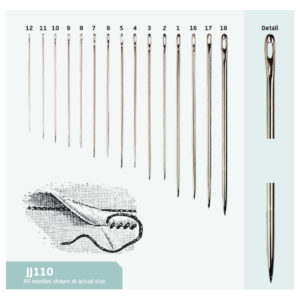
Today we have a guest post.
With just a needle and some thread, you can create notable works of art using the time-honored and complex craft of needlepoint. But picking the appropriate tool—the needle—is the first step to needlepoint excellence. Your choice of needle can significantly influence the outcome of your project, including the stitch texture and general aesthetic of your creation. In this guide, we’ll examine the technique of selecting the ideal needle for your needlepoint projects.
Types of Needles for Needlepoint
The first step in choosing the best needle for your needlepoint project is to be aware of the various styles that are out there. Each kind of needle has a specific function, so you should match your selection to the needs of your project.
Tapestry Needles: These are the needlepoint workhorses. The tapestry needle is a flexible tool with wide eyes and blunt points. They are ideal for tasks requiring several strands of yarn or thread. Tapestry needles are a solid option for sewing a wall hanging or a beautiful pillow.
Specialty Needles: There are specialty needles to consider in addition to the essentials. Blunt-end, bent-tip, and curved arrows can be extremely useful for particular stitch patterns or difficult fabrics.
Factors to Consider When Choosing a Needle
Knowing the many available varieties is essential, but choosing the proper needle also requires taking into account several other factors to make sure that it meets the requirements of your project.
Yarn or Thread Size: To get the proper tension, it is essential to match the size of your needle to the yarn or thread. A hand that is too big can result in sloppy, loose stitches, while a too-little needle might result in tight, challenging stitches.
Fabric Type: If you are stitching on fabric, for example using waste canvas, you may need to use a different kind of needle. To choose the correct needle, pay special attention to the properties of your material.
Project Complexity: Your project’s complexity will also impact your preferred needles. While simpler patterns can work with larger needles, intricate, detailed designs and specialized techniques frequently benefit from using other needles.
Personal Preferences: Remember your own stitching and comfort preferences. Consider the mesh size, thread, and comfort that feels best in your hand. Using a needle that matches your tastes will make needlepoint more fun.
Needlepoint Techniques and Needle Selection
Making an appropriate needle choice requires knowledge of the needlepoint techniques you will be using.
Traditional Needlepoint: Tapestry needles are frequently used in conventional needlepoint because of their versatility. The final appearance of your creation may vary depending on whether you use blunt- or round-end tapestry needles.
In comparison to round-end needles, blunt-end hands produce a somewhat different texture.
Specialty Techniques: Certain stitches and methods call for specific needles. For example, beading needles are necessary to add beads to your needlepoint masterpieces, while sharp-pointed needles are best for tying French knots.
Tips for Needle Care and Maintenance
The longevity of your equipment and the excellence of your job are both guaranteed by proper needle care.
Cleaning and Storing Needles: To avoid rust and corrosion, clean your needles frequently and store them correctly. After each usage, a quick wipe with a soft, dry cloth can help keep your needles in good condition.
Avoiding Rust and Corrosion: Needles are susceptible to rusting when left in wet or humid circumstances. To prevent corrosion, ensure your needle storage is dry and well-ventilated.
Discard needles that are bent or discolored.
Troubleshooting Needle Issues
Despite your best efforts, you could run into problems with needle selection.
Tension Problems: Your stitches may only be tensioned properly if you use the right needle. It might be time to reconsider your needle selection if your stitches seem excessively slack or tight.
Damage to Fabric or Threads: Your canvas or threads may become frayed if you use an improper needle. If you experience these problems, think about switching to a different kind of needle.
Preventing Future Problems: To prevent issues in the future, use the lessons you’ve learned. You’ll develop a feeling for which needle is best for each project as you gain more experience.
The needle is your dependable travel partner as you go on a creative journey in the needlepoint world. Selecting the proper needle requires art as well as technical judgment. Your needlepoint abilities will advance as you continue to investigate and experiment with various needles, and your artistic dreams will come to life stitch by stitch.
About the Author
Muhammad Asim is a dedicated writer in the world of art and crafts. With a passion for creativity, he explores various mediums, from intricate needlework to captivating paintings. Through insightful articles, Asim shares the magic of artistic expression, inviting readers to discover the joy of crafting and the beauty of handmade creations. Join Muhammad on a journey of inspiration and imagination in the world of crafts on his blog “The Pak Crafts.”
About Janet M Perry
Janet Perry is the Internet's leading authority on needlepoint. She designs, teaches and writes, getting raves from her fans for her innovative techniques, extensive knowledge and generous teaching style. A leading writer of stitch guides, she blogs here and lives on an island in the northeast corner of the SF Bay with her family

Leave a Reply